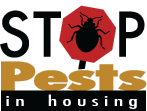What health and safety hazards are associated with pests?
The Centers for Disease Control and Prevention host the most up-to-date information on the health significance of pests. Many urban pests are classified as “pests of public health significance” because they
- Trigger/cause asthma and allergies (including skin reactions);
- Contaminate food;
- Lead people to overreact and ignore pesticide labels; and/or
- Transmit disease.
A few examples:
- Cockroaches
The National Institute of Environmental Health Sciences reports that one-in-five children in the United States have severe sensitivities to cockroach allergens, which increase the severity of asthma symptoms. Cockroaches can also carry bacteria such as E. coli and salmonella on their bodies, which can contaminate food, cooking equipment and food surfaces. - Rodents
Rodent droppings most often cause allergic reactions in human beings but can also cause disease, including the potentially deadly hantavirus. Rodent urine (which they use to mark trails), is linked to asthma in children. More frequently, though, rodents serve as vectors, carrying bacteria, such as salmonella, on their bodies and contaminating food sources, kitchen surfaces and equipment. - Mosquitoes
Mosquitoes can transmit West Nile Virus, Encephalitis, Dengue Fever, and Malaria—these are serious diseases. In addition, they cause itchy, unsightly marks as well as severe allergic reactions in human beings. - Ticks
Ticks transmit more than Lyme disease—Anaplasmosis, Babesiosis, Ehrlichiosis, Rickettsiosis, Rocky Mountain Spotted Fever, Southern Tick-Associated Rash Illness, Tick-borne Relapsing Fever, and Tularemia to name a few! Seeing a biting tick causes distress for good reason. - Summer Stingers (Bees, Yellow Jackets, Hornets, etc)
Stinging pests send more than 500,000 people to the emergency room each year. The painful sting is reason enough to avoid them, but if someone is allergic the sting is life threatening.
